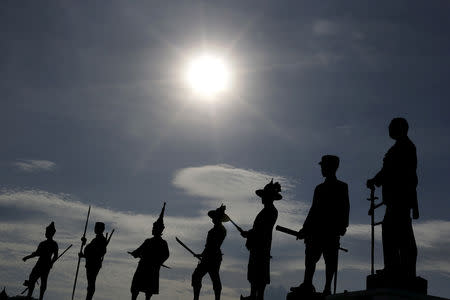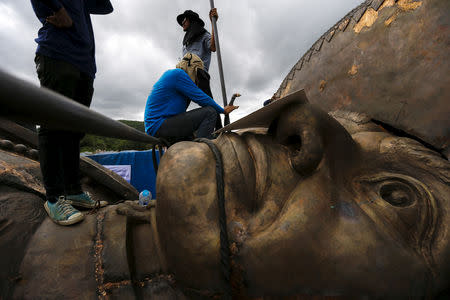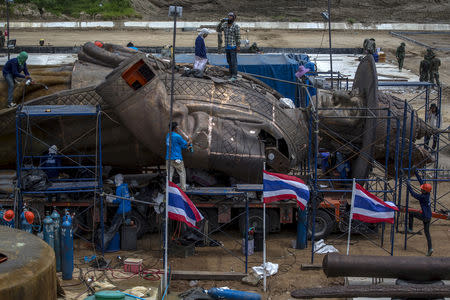The 10 Ramas: the kings of Thailand's Chakri dynasty
BANGKOK (Reuters) - Thailand's King Maha Vajiralongkorn on Thursday paid tribute to his ancestors in a ceremony ahead of his official coronation this weekend, when he will take the formal title King Rama X, the 10th king in the Chakri dynasty.
In a tradition dating to the 18th century, the Chakri kings have held the formal title Rama, after an avatar of Hindu god Vishnu in the ancient Indian epic the Ramayana.
Here are details of the nine previous kings in the dynasty:
Rama I - King Phra Buddha Yodfa Chulaloke (born 1737-died 1809)
Phra Buddha Yodfa Chulaloke founded the Chakri dynasty and established Bangkok as the capital of Siam, as Thailand was known, in 1782.
He ruled for 27 years and is best known for repelling the last major Burmese attack on Siam, known as the Nine Armies' Wars, from 1785 to 1786.
Rama II - King Phra Buddha Loetla Nabhalai (1767-1824)
King Phra Buddha Loetla Nabhalai succeeded his father in 1809 and ruled for almost 15 years.
His reign was more peaceful. Art and literature flourished. The king was an avid composer of poetry, plays and songs.
The most notable poet under the king's patronage was Sunthorn Phu, known as the "the Shakespeare of Thailand" for his role in literature.
Rama III - King Phra Nangklao (1788-1851)
King Phra Nangklao reformed the tax and treasury system and oversaw a boom in trade with China during his 27-year rule from 1824.
Siam renewed official contacts with western powers for the first time since the late Ayutthaya period, and supported the British in their first Anglo-Burmese War in 1824.
The king did not name a successor and the throne passed to his half-brother.
Rama IV - King Mongkut (1804-1868)
Probably the best-known king of Siam in the West, Mongkut was portrayed in the 1951 Broadway musical "The King and I" and later in a 1956 Hollywood film.
Under growing Western pressure during his 17-year reign, Mongkut signed the Bowring Treaty with the British Empire that abolished a royal monopoly over foreign trade.
Mongkut later died from malaria that he contracted while on an expedition to see a total eclipse of the sun.
Rama V - King Chulalongkorn (1853-1910)
The 42-year reign of King Chulalongkorn, the son of Mongkut, was known for a modernization drive and abolition of slavery.
He also ceded territories to Western powers, including Laos and Cambodia to France, and the Malay sultanates of Kedah, Kelantan, Terengganu and Perlis to Britain.
Chulalongkorn was the first Siamese king to send royal princes to study in Europe. He visited twice and presented Siam as a modern nation to European rulers.
Rama VI - King Vajiravudh (1881-1925)
Vajiravudh's reign was characterized by the creation and promotion of Siamese nationalism. He modernized the military and sent troops to join Allied forces in World War One.
He quashed an attempted coup in 1912 by disgruntled military officers who accused the king of financial extravagances and sought to establish democratic rule.
Rama VII - King Prajadhipok (1893-1941)
Prajadhipok was Siam's last absolute monarch and its first constitutional monarch after the Siamese Revolution of 1932.
Educated at Eton, he succeeded his brother in 1926. Six years later a group of military officers and civil servants initiated a near bloodless coup.
Prajadhipok abdicated in 1935 and spent the rest of his life with his wife in England. The couple had no children.
Rama VIII - King Ananda Mahidol (1925-1946)
Ananda ascended to the throne after his uncle abdicated. His father, Prince Mahidol, was a son of King Chulalongkorn.
Ananda was nine years old and studying in Switzerland when he was chosen to succeed Prajadhipok. The government changed the country's name to Thailand in 1939.
In 1946, Ananda, 20, was found shot dead in his bedroom inside Bangkok's Grand Palace in mysterious circumstances, four days before his planned return to school in Switzerland.
Rama IX - King Bhumibol Adulyadej (1927-2016)
Bhumibol succeeded his brother in 1946 and reigned for 70 years, the world's longest reigning monarch when he died.
The American-born king became the face of Thailand, blending tradition with modernity and traveling the world with Queen Sirikit.
During his reign the country had 30 prime ministers, 10 successful military coups and 17 constitutions. His intervention in several political crises helped to end bloodshed.
He was awarded the United Nations' first Human Development Lifetime Achievement Award for more than 3,000 royal development projects.
(Reporting by Panu Wongcha-um; Editing by Darren Schuettler)





